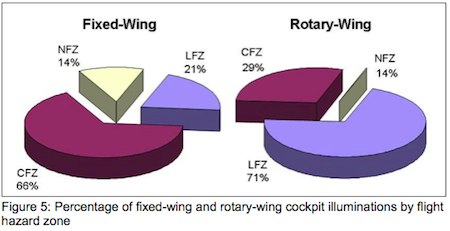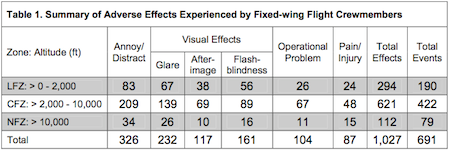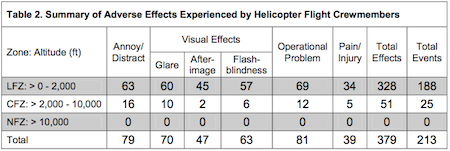Home
A comprehensive resource for safe and responsible laser use

2013 FAA helicopter study
In April 2013, the FAA released a study comparing laser illumination of fixed-wing aircraft (airplanes) with rotary-wing aircraft (helicopters) . They looked at 12,248 incidents reported to FAA, that occurred in the U.S. from 1980 through 2011. During this time, there were 11,014 fixed-wing and 1,234 rotary-wing aircraft illuminations.
Illuminations: fixed-wing vs. helicopters
For fixed-wing aircraft, 21% of cockpit illuminations occurred below 2,000 feet in altitude. (This is the so-called “Laser Free Zone” where aircraft are not to be exposed to laser light above 50 nanowatts per square centimeter. This light level is very dim; the laser would not appear to be brighter than other city or airport lights.) This compares with helicopter exposures, where 71% occurred below 2,000 feet.
The diagram below summarizes the authors’ findings:

LFZ = Laser Free Zone = Laser illumination occurred less than 2,000 feet
CFZ = Critical Flight Zone = Laser illumination occurred between 2,000 and 10,000 feet
NFZ = Normal Flight Zone = Laser illumination occurred above 10,000 feet
Adverse effects: fixed-wing vs. helicopters
For illuminations resulting in adverse effects, 29% of fixed-wing adverse effects occurred below 2,000 feet, versus 86% of helicopter adverse effects. Here is data breaking down the adverse effects by type of aircraft and altitude zone:

The above is based on 7,389 reported fixed-wing illuminations; thus, 9.4% of fixed-wing illuminations (n=691) resulted in adverse effects.
The above is based on 1,004 reported helicopter illuminations; thus, 21% of helicopter illuminations (n=213) resulted in adverse effects.
Adverse effects by type of flight
For fixed-wing aircraft where pilots reported adverse effects, the majority (79%) were commercial flights, followed by general aviation (small aircraft) at 12%. For helicopters, law enforcement suffered the most adverse effects (52%), followed by medical (18%), military (11%), and “other” (10%).

Reasons why helicopters are at greater low-altitude risk
From the study’s Discussion section: “Helicopters routinely operate at lower attitudes and slower speeds than fixed-wing aircraft, making them easy targets for laser beam illuminations…. [H]elicopter flight crewmembers may also be more susceptible to visual impairment from laser beam exposures due to the large bubble canopies characteristic of these aircraft. These canopies can allow more light to enter at various angles to scatter and reflect throughout the cockpit, thereby increasing the chances for adverse visual and/or operational effects.”
They noted that “One explanation for the high percentage of police helicopter illuminations is that they are often sent to investigate after other aircraft have been illuminated, placing them in airspace where laser exposures have already occurred and are more likely to happen again. Ironically, the perpetrators have often illuminated police helicopters, thereby revealing their location and assisting in their own arrest.”
Conclusion
The authors concluded that “special protective measures may be needed for helicopters and other low-flying aircraft outside of designated airport hazard zones due to the higher percentage of adverse effects associated with these events and the increased risk inherent in low-altitude flight operations. These results may also justify the expense of equipping rotary-wing aircraft (particularly law enforcement aircraft) with laser detection and tracking devices to improve the possibility of apprehending perpetrators of these offenses.”
Links
- Montgomery, Ron W. and Wood, Kathryn J., Laser Illumination of Helicopters: A Comparative Analysis with Fixed-Wing Aircraft for the Period 1980-2011, DOT/FAA/AM-13/8, Office of Aerospace Medicine, Washington DC. and Civil Aerospace Medical Institute, Federal Aviation Administration, Oklahoma City, OK, April 2013.